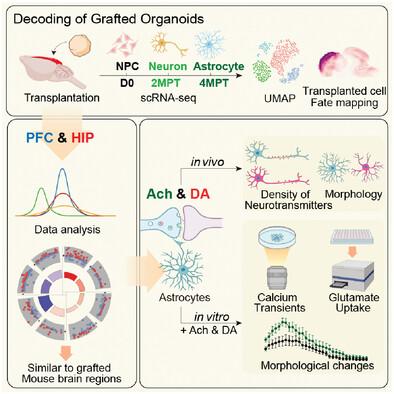Our official English website, www.x-mol.net, welcomes your feedback! (Note: you will need to create a separate account there.)
Single‐Cell Transcriptome Landscape and Cell Fate Decoding in Human Brain Organoids after Transplantation
Advanced Science ( IF 15.1 ) Pub Date : 2024-05-07 , DOI: 10.1002/advs.202402287 Shi‐Bo Xu 1, 2 , Xin‐Rui Li 1 , Pan Fan 2 , Xiyang Li 2 , Yuan Hong 1 , Xiao Han 1 , Shanshan Wu 1 , Chu Chu 1 , Yuejun Chen 3 , Min Xu 1 , Mingyan Lin 2 , Xing Guo 2, 4 , Yan Liu 1
Advanced Science ( IF 15.1 ) Pub Date : 2024-05-07 , DOI: 10.1002/advs.202402287 Shi‐Bo Xu 1, 2 , Xin‐Rui Li 1 , Pan Fan 2 , Xiyang Li 2 , Yuan Hong 1 , Xiao Han 1 , Shanshan Wu 1 , Chu Chu 1 , Yuejun Chen 3 , Min Xu 1 , Mingyan Lin 2 , Xing Guo 2, 4 , Yan Liu 1
Affiliation

|
Human stem cells and derivatives transplantation are widely used to treat nervous system diseases, while the fate determination of transplanted cells is not well elucidated. To explore cell fate changes of human brain organoids before and after transplantation, human brain organoids are transplanted into prefrontal cortex (PFC) and hippocampus (HIP), respectively. Single‐cell sequencing is then performed. According to time‐series sample comparison, transplanted cells mainly undergo neural development at 2 months post‐transplantation (MPT) and then glial development at 4MPT, respectively. A different brain region sample comparison shows that organoids grafted to PFC have obtained cell fate close to those of host cells in PFC, other than HIP, which may be regulated by the abundant expression of dopamine (DA) and acetylcholine (Ach) in PFC. Meanwhile, morphological complexity of human astrocyte grafts is greater in PFC than in HIP. DA and Ach both activate the calcium activity and increase morphological complexity of astrocytes in vitro. This study demonstrates that human brain organoids receive host niche factor regulation after transplantation, resulting in the alignment of grafted cell fate with implanted brain regions, which may contribute to a better understanding of cell transplantation and regenerative medicine.
中文翻译:

移植后人脑类器官的单细胞转录组景观和细胞命运解码
人类干细胞及其衍生物移植广泛用于治疗神经系统疾病,但移植细胞的命运决定尚不清楚。为了探究人脑类器官移植前后细胞命运的变化,将人脑类器官分别移植到前额皮质(PFC)和海马(HIP)。然后进行单细胞测序。根据时间序列样本比较,移植细胞分别主要在移植后 2 个月(MPT)进行神经发育,然后在 4MPT 进行神经胶质发育。不同脑区样本比较表明,移植到PFC的类器官获得了与PFC中宿主细胞接近的细胞命运,而不是HIP,这可能是受到PFC中多巴胺(DA)和乙酰胆碱(Ach)丰富表达的调节。同时,PFC 中的人星形胶质细胞移植物的形态复杂性高于 HIP。 DA 和 Ach 均可激活钙活性并增加体外星形胶质细胞的形态复杂性。这项研究表明,人脑类器官在移植后受到宿主生态位因子的调节,导致移植细胞的命运与植入的大脑区域保持一致,这可能有助于更好地理解细胞移植和再生医学。
更新日期:2024-05-07
中文翻译:

移植后人脑类器官的单细胞转录组景观和细胞命运解码
人类干细胞及其衍生物移植广泛用于治疗神经系统疾病,但移植细胞的命运决定尚不清楚。为了探究人脑类器官移植前后细胞命运的变化,将人脑类器官分别移植到前额皮质(PFC)和海马(HIP)。然后进行单细胞测序。根据时间序列样本比较,移植细胞分别主要在移植后 2 个月(MPT)进行神经发育,然后在 4MPT 进行神经胶质发育。不同脑区样本比较表明,移植到PFC的类器官获得了与PFC中宿主细胞接近的细胞命运,而不是HIP,这可能是受到PFC中多巴胺(DA)和乙酰胆碱(Ach)丰富表达的调节。同时,PFC 中的人星形胶质细胞移植物的形态复杂性高于 HIP。 DA 和 Ach 均可激活钙活性并增加体外星形胶质细胞的形态复杂性。这项研究表明,人脑类器官在移植后受到宿主生态位因子的调节,导致移植细胞的命运与植入的大脑区域保持一致,这可能有助于更好地理解细胞移植和再生医学。






























 京公网安备 11010802027423号
京公网安备 11010802027423号